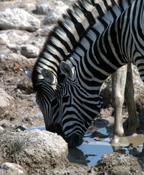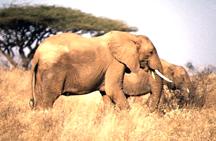|
 Tropical
Savannah: Animals Tropical
Savannah: Animals
The species of
animals in a savanna depends upon the geographic location of the
biome. The African savannah, the savannah with which most people
are familiar, is home to a wide variety of animals. A short list
of some of those animals includes wildebeest, warthogs, elephants,
zebras, rhinos, gazelles, hyenas, cheetahs, lions, leopards, ostrich,
mousebirds, starlings, and weavers.
Animal adaptations
During the rainy season, birds, insects, and both large and small
mammals thrive in the savannah, but the rainy season only lasts
6 to 8 months. During the dry season, surface water from the rain
is quickly absorbed into the ground because the soil is extremely
porous. Competition for water during the dry season is intense.
Consequently, most birds and many of the large mammals migrate during
the dry season in search of water. Because drought conditions are
sometimes localized, the migration may be just to another area within
the savannah. When drought conditions exist for a long time and
over a wide area, the animals may migrate to another biome until
the rainy season begins again.
 Although
elephants do migrate, they have a physical adaptation that allows
them to access water that is not available to other animals. Baobab
trees store water in their large trunks. The elephant's physical
strength and anatomy allow it to tear open the trunk of the baobab
tree and to suck the water from it. An adaptation used by small
burrowing animals is to remain dormant during times of drought--much
like bears do during the winter in other biomes.
Photos © 2000-www.arttoday.com Although
elephants do migrate, they have a physical adaptation that allows
them to access water that is not available to other animals. Baobab
trees store water in their large trunks. The elephant's physical
strength and anatomy allow it to tear open the trunk of the baobab
tree and to suck the water from it. An adaptation used by small
burrowing animals is to remain dormant during times of drought--much
like bears do during the winter in other biomes.
Photos © 2000-www.arttoday.com
During the dry season,
lightning frequently ignites the brown, dry grasses that cover the
savannah. Many of the animals have adapted to living with the fires.
The ability to fly or to run fast enables most birds and large mammals
to escape the flames. Some birds, such as the Fork-tailed Drongos,
actually are attracted to the active fires. These birds feast on
fleeing or flame-roasted insects. Although small burrowing animals
may not be able to outrun the flames, they frequently survive the
fire by digging beneath the soil and remaining there until the flames
pass by them.
Back
| Next
|











